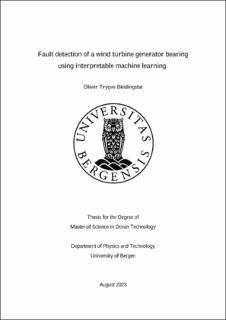Fault detection of a wind turbine generator bearing using interpretable machine learning
Master thesis
Permanent lenke
https://hdl.handle.net/11250/3085872Utgivelsesdato
2023-08-10Metadata
Vis full innførselSamlinger
- Master theses [170]
Sammendrag
A wind turbine is subjected to a number of degradation mechanisms during its operational lifetime. If left unattended, the degradation of components will result in poor performance and potential failure. Hence, to mitigate the risk of failures, it is imperative that the wind turbines are regularly monitored, inspected, and optimally maintained. Offshore wind turbines are normally inspected and maintained at fixed intervals (generally six-month intervals) and the maintenance program (list of tasks) is prepared using experience or risk-based reliability analysis, like risk-based inspection (RBI) and reliability-centered maintenance (RCM). This time-based maintenance program can be improved by incorporating results from condition monitoring (CM) involving data acquisition using sensors and fault detection using data analytics. It is important to ensure quality and quantity of data and to use correct procedures for data interpretation for fault detection to properly carry out condition assessment. This thesis contains the work carried out to develop a machine learning (ML) based methodology for detecting faults in a wind turbine generator bearing. The methodology includes application of ML using supervisory control and data acquisition (SCADA) data for predicting the operating temperature of a healthy bearing, and then comparing the predicted bearing temperature with the actual bearing temperature. Consistent abnormal differences between predicted and actual temperatures may be attributed to the degradation and presence of a fault in the bearing. This fault detection can then be used for rescheduling the maintenance tasks. The methodology is discussed in detail using a case study. In this thesis, interpretable ML tools are used to identify faults in a wind turbine generator bearing. Furthermore, variables affecting the generator bearing temperature are investigated. The analysis used two years of operational data from a 2 MW offshore wind turbine located in the Gulf of Guinea off the west coast of Africa. Out of the four ML models that were evaluated, the XGBoost model was determined to be the most effective performer. After utilizing the Shapley additive explanations (SHAP) to analyze the XGBoost model, it was determined that the temperature in the generator phase windings had the most significant effect on the model's predictions. Finally, based upon the deviation between the actual and the predicted temperatures, an anomaly in the generator bearing was successfully identified two months prior to a generator failure occurring.
